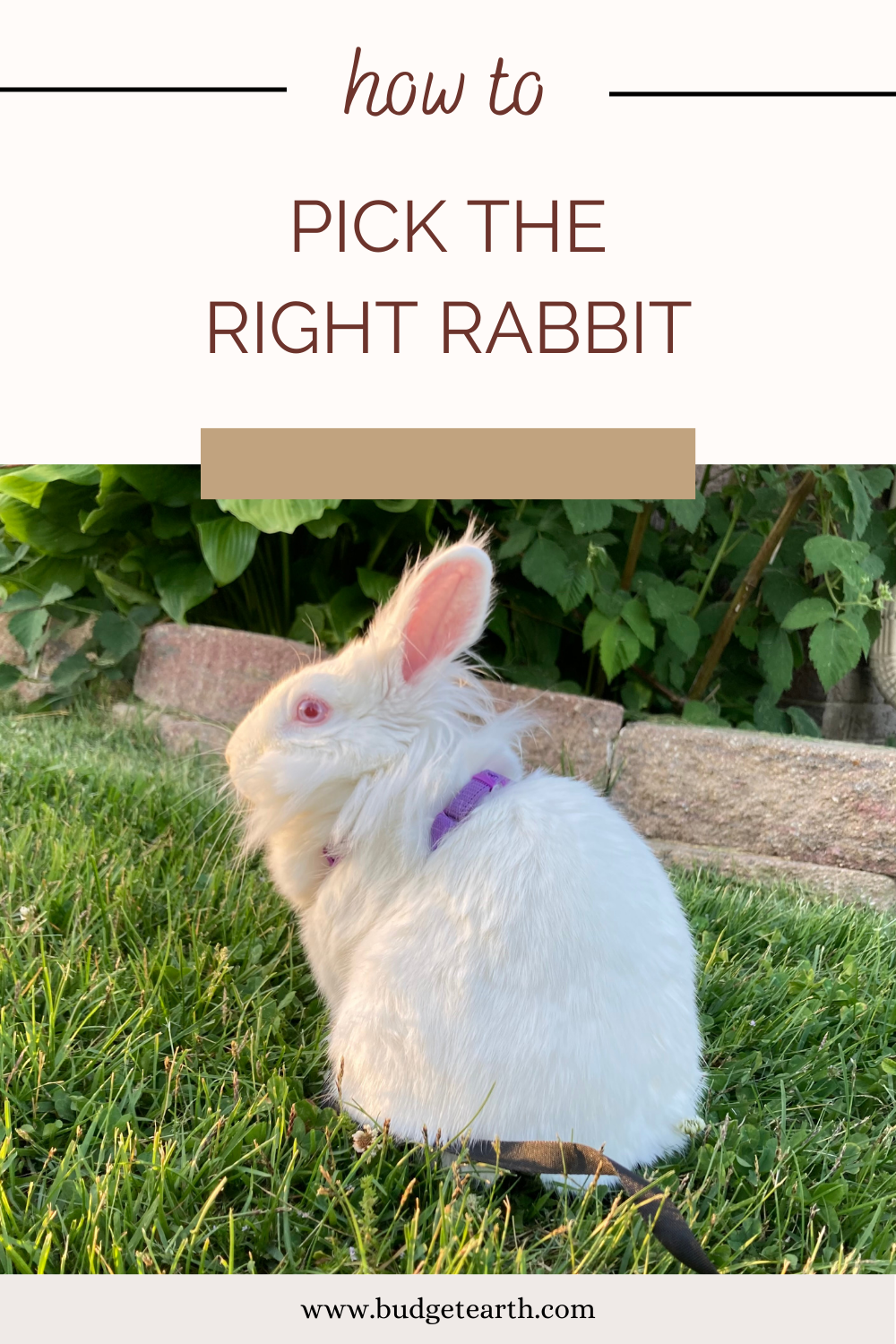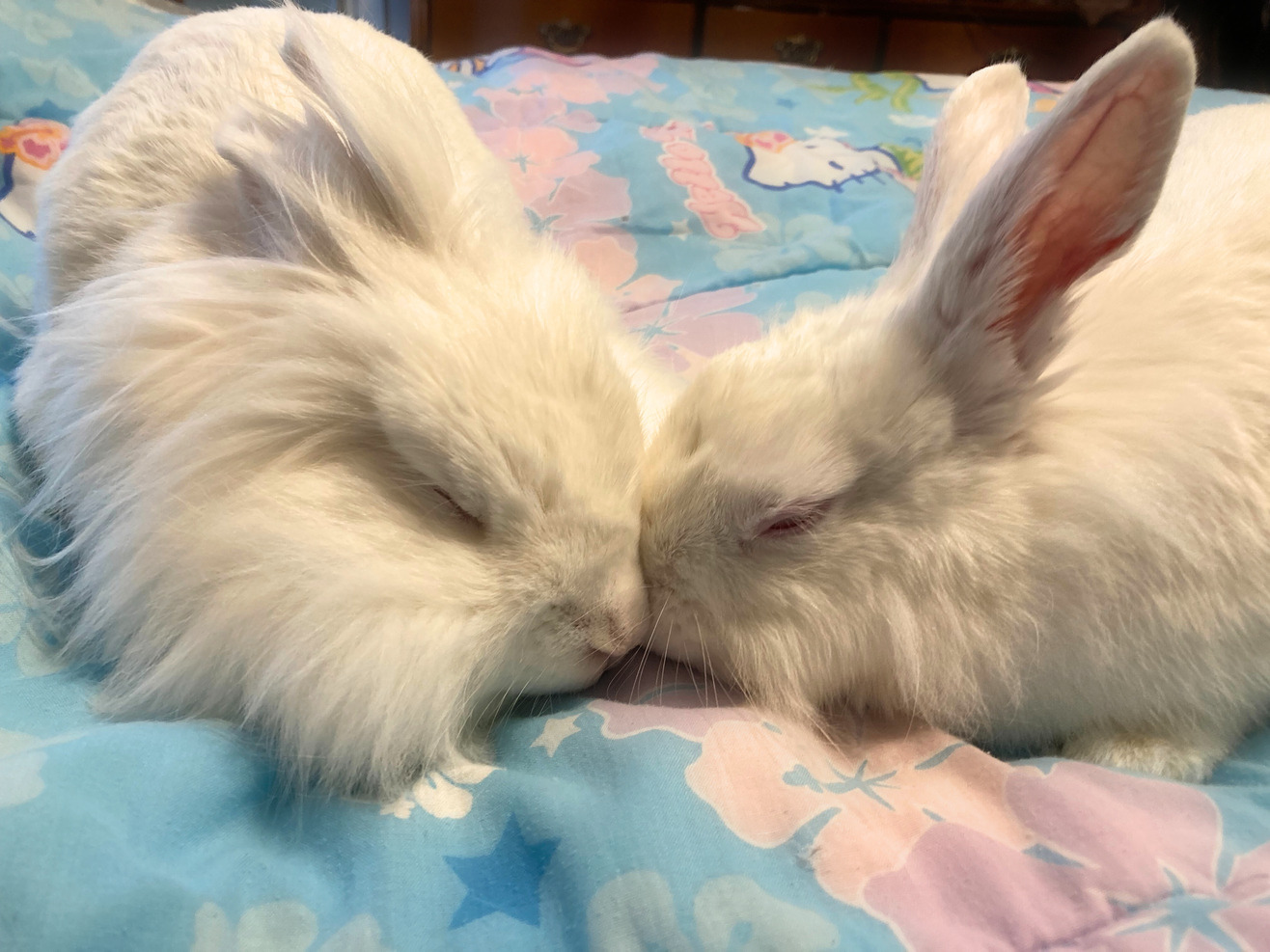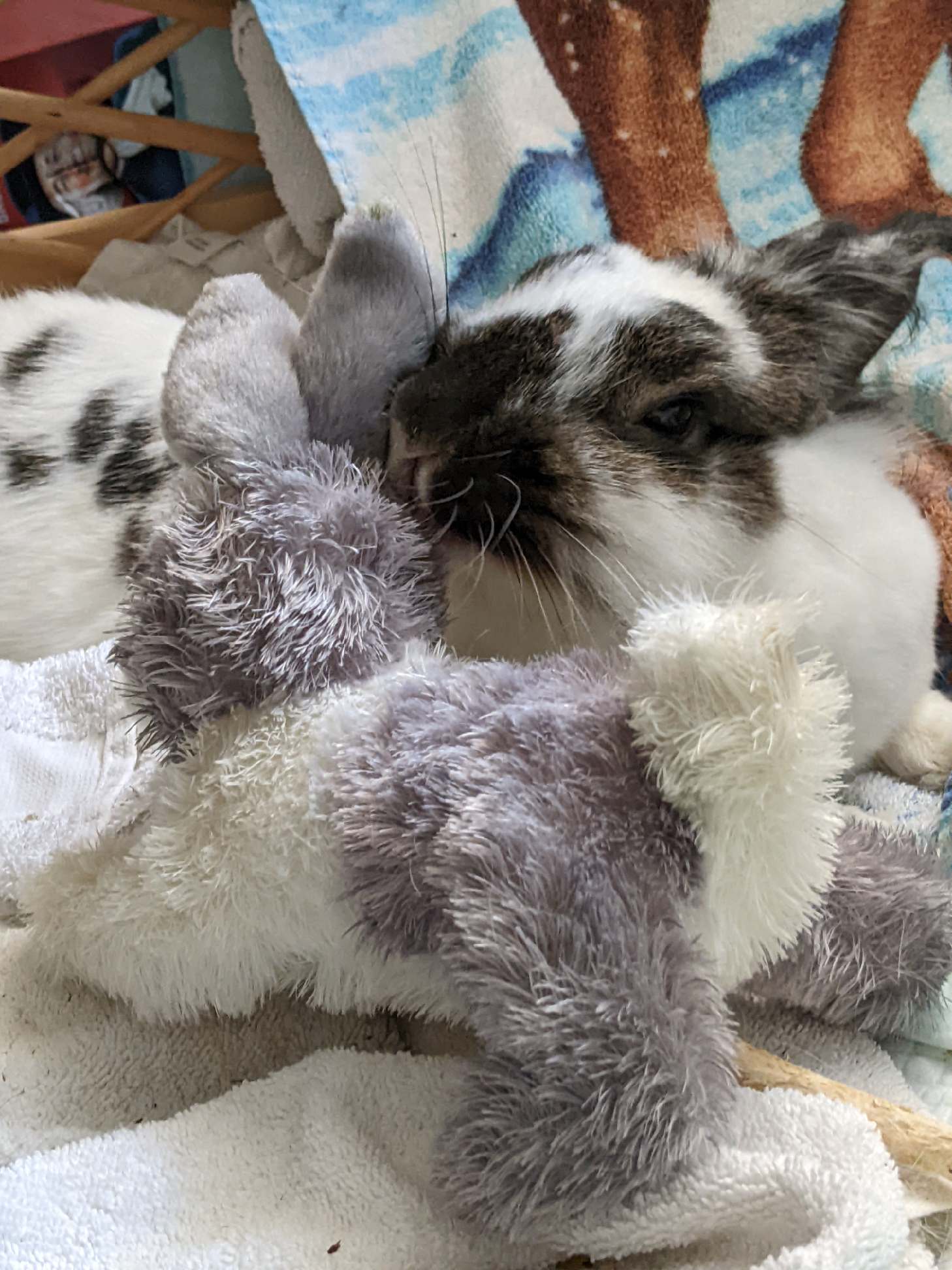Have you decided that a rabbit is the right pet for you? Considered factors in your life such as whether you have children (rabbits aren’t good pets for young kids), allergies (hay, the main source of a rabbit’s diet, is not an uncommon one), other pets (like cats or dogs), the budget and necessary space, and most importantly the time in your life to spend giving care and attention to a new friend? There is a bunny out there waiting for you to bring them home and love them, but how do you know what kind of rabbit to choose? How do you decide what kind of rabbit is best for you and your family? There are plenty of other factors to consider than just color and cuteness!
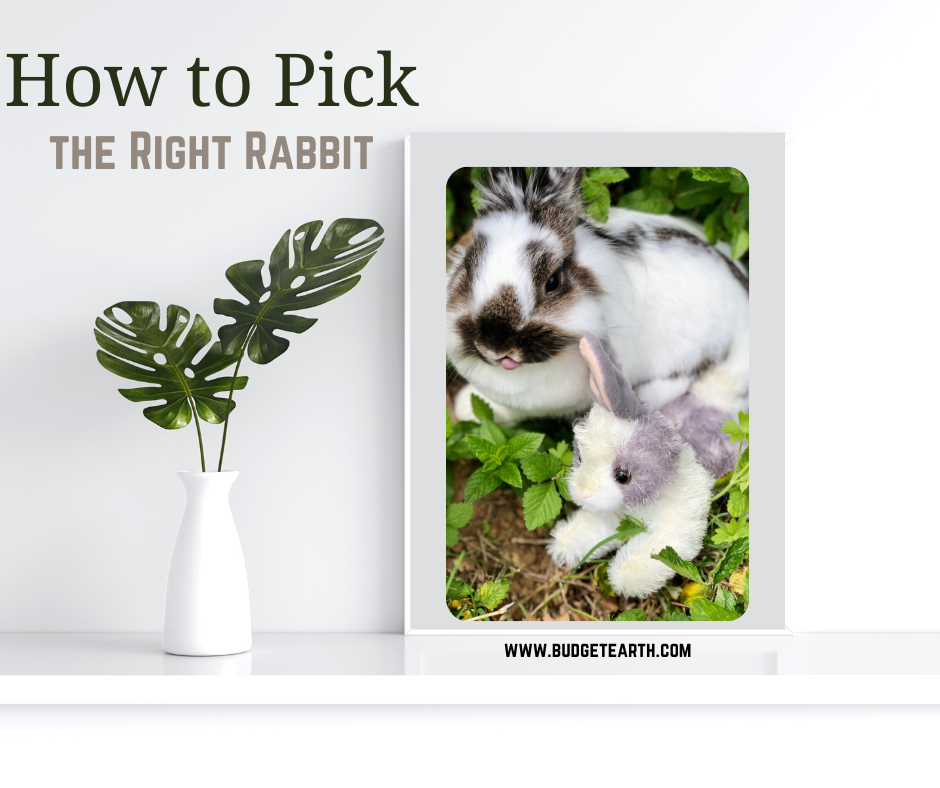
My two bunnies, Biscotti (left) and Bellini,
soon after we brought her home from the rescue in December 2021.
General Tips for Rabbits
Perhaps the most obvious things to look at when choosing a rabbit are whether the rabbit is healthy and if its environment is clean. Healthy rabbits are usually alert and curious when they are active and have well-groomed, shiny fur without any bare patches or obvious wounds (a lesser known place to check for sores is on the heels of their feet). Rabbits shouldn’t be reluctant to move or show lameness or stiffness.
Other potential signs of medical problems may include a mucky bum or fur that is wet or matted (particularly around the chin or under the tail), discharge from the eyes (my rescue bunny Bellini had red, teary eyes that turned out to be conjunctivitis) or nose, and discharge or crusting in the ears (Bellini had been treated but had scabs and damaged ears from a bad case of ear mites).
This is not to say bunnies with problems, particularly at rescues, don’t deserve to be adopted – they may just require extra time, money, and patience.
Opal’s baby came from the store.
Where to Buy Your Rabbit – Pet Store vs. Rescue or Shelter
Something you may not typically consider when it comes to health is an animal’s stress level. Have you ever bought a hamster only to have it pass away days later, or maybe you’ve noticed the signs at a pet store saying an animal only comes with a 3 day guarantee? The stress levels an animal has been subjected to prior to coming home with you can mean the difference between starting with a healthy bunny or one already succumbing to (often fatal) stress-induced illness.
How do you know if an environment is stressful? If the environment includes most of the following criteria, it should be relatively low stress:
- fairly quiet noise levels
- a place for the rabbit to hide if it wants to
- clean surroundings with access to unlimited fresh water and hay
- fairly constant temperatures; no fluctuating extremes
- a place for the rabbit to run and exercise daily
- the company of other rabbits, compatible animals, and/or people to interact with
- knowledgeable workers who understand rabbit care
Unfortunately, pet stores do not typically fit the bill.
Did you know rabbits are the third most abandoned pet in America? This means that rescues are often quite full, and your local shelter is likely home to bunnies as well. While pet stores typically resell bunnies from mass breeders, there are some who will host adoption events alongside shelters, so check to make sure you know what kind of business you’re supporting.
I would always recommend adopting a bunny over buying one from a pet store.
The people who work in shelters and rescues know the rabbits. They often know the rabbit’s backstory, the breed, how best to care for the rabbit, its litterbox habits, and if the bun is used to being handled or being around other animals. They’ll likely ask you questions, too, to make sure you understand what’s involved in rabbit care because they want their bunnies to be well taken care of. This is great for both you and the rabbit because they can help you find the perfect bunny suited to your family and home!
Shelters and rescues may have a higher fee upfront than pet stores, but the cost saves you money in the long run because they vaccinate and spay or neuter their bunnies. Rabbits require exotic veterinarians for their care and as such these procedures can run a bit costly otherwise.
But what if you really can’t find a rabbit you want at the shelter or a nearby rescue? What if you’re not interested in a little more traveling to find yourself a new friend? In that instance, here are some ways to identify a good pet store:
- There is a lot of information readily available. Good pet stores want you to know everything necessary about caring for your new pet. The people working should be able to answer your questions and even offer information sheets for you to take home.
- Trained staff. When I went to the animal shelter with my brother to pick out a friend for his bunny, we had to wait for their “bunny expert” to help us. This was actually great because when we met her we knew she had the knowledge and expertise to help us make informed decisions. Employees that are trained on specific species can help you identify organizations that prioritize the needs of the animals over moving along quick sales.
- Regular health checks on the rabbits. No nasty bottoms, runny eyes or noses. Sick pets are isolated from others, and enclosures are kept clean.
- Space. Rabbits should have space to explore and play. Are they housed in a small hutch or pen? Do they have room to stretch out, hop around and jump or are they all in a small enclosure together?
- Enrichment. Rabbits get bored easily and enjoy toys, tunnels, blocks and places to hide. Do they have anything to entertain themselves in their enclosure?
- Food. The rabbits have access to unlimited clean hay and water, not just pellets.

Don’t write me off if I’m a little shy!
Rabbit Personality
Regardless of breed, rabbits have their own unique personalities. Discovering a bunny’s character is perhaps the most fun part of meeting new rabbits! Rescues will have a wide variety of bunnies for you to meet and get to know. Knowledgeable workers or volunteers may also be able to tell you more about a particular rabbit: whether it is shy or adventurous, whether it is well socialized and likes to be cuddled, and whether it loves to play and explore. Rabbits can adapt to their human’s schedule but are usually crepuscular, meaning they are most active in the early morning and evening. Visiting at these times of day may give you a better picture of a rabbit’s temperament.
Let it be said that there are no mean rabbits, just bunnies who react in a predictable manner to their environment and past (or present) treatment. As prey animals they can be wary and shy to start with (you could be a potential predator!), but if you’re willing to take the time to gain a bunny’s trust you’re sure to gain a lifelong friend. Most rabbits are clean, sociable, and affectionate once they get to know you.
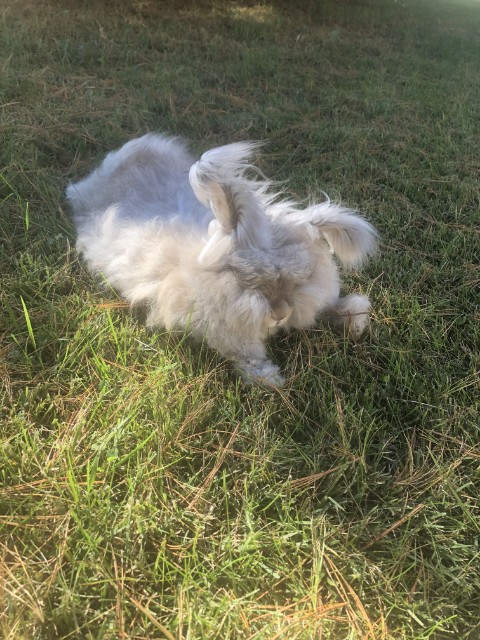
I am the cutest and fluffiest, but my fur is like velcro.
I need a lot of help keeping it nice.
Rabbit Breeds
When choosing a rabbit of a particular breed, think about who the rabbit is for. If you are an adult who plans to supervise younger children with the rabbit, larger breeds might be better as they are often calmer and more robust. Smaller rabbits require greater care when handling and are better suited for adults and responsible older children.
Certain breeds require special care. Short-haired rabbits may require brushing only once or twice a week to help remove excess shedding hair, but breeds like angoras have long hair that requires constant grooming (daily brushing, as they are prone to mats and intestine blockages, and trims to prevent eye infections, tangles, and other problems) and special diets. Rabbits with very long ears, such as English lops, may need more monitoring because their ears are prone to infections and scratches. Ask the workers if the rabbit you’re considering has any special care required.
The only other real consideration with respect to the size of the breed you choose is the size of the space that you can provide for housing (and if for a baby rabbit, the proper amount of space for its adult size). A good guideline for rabbits who’ll spend significant parts of the day in their pens is for the pen to be at least twice the length of the rabbit (when the rabbit is fully stretched out) and at least as wide and high as the (stretched out) rabbit is long. Perhaps an easier recommendation to follow is to provide at least one square foot per pound of rabbit.
Babies or Adults
There’s no question that baby bunnies (kits) are the absolute cutest, but there are benefits to choosing adult rabbits over babies. Adult rabbits are easier to litterbox train because they instinctively choose one or two places for their potties. They are often already socialized (although as with any new pet, give them a little time to settle in and adjust), and they are also more predictable in terms of behavior.
Kits usually go through personality changes in their first year of life due to hormone fluctuations, so the sweet bunny you bring home may not be the same bunny you have temperamentally in a few months’ time. Babies may spray or even attack unpredictably due to their changing hormones. If you’re looking for a cuddle bunny, consider that – like many baby animals – kits are so full of energy and curiosity about the world that they tend to hate being restrained in someone’s arms.
In short, babies require a lot of extra time, patience, and care. It may be best to choose an older rabbit who is past adolescence, preferably one who is spayed or neutered and whose hormone levels have evened out.
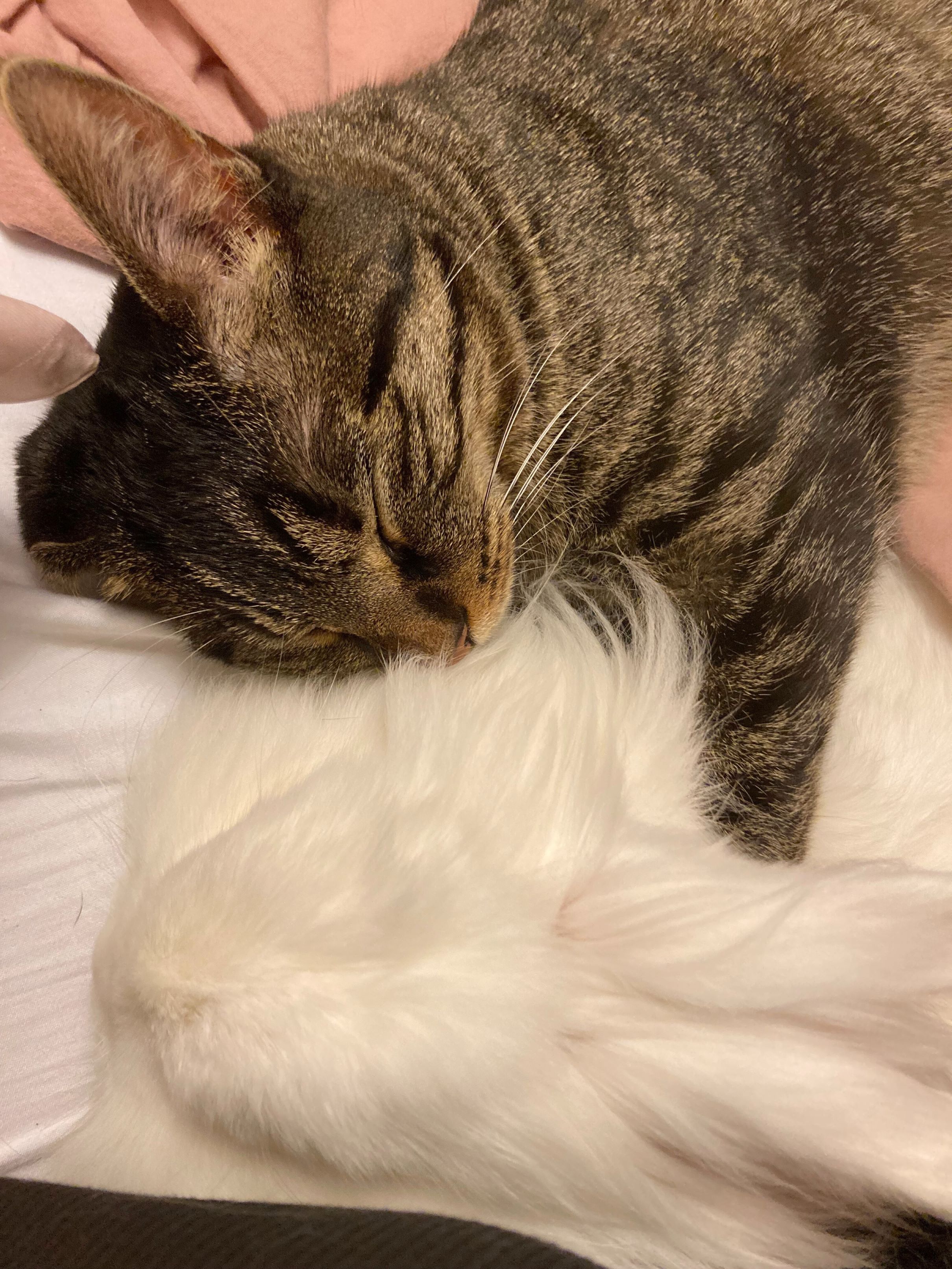
My cat Truffles loves to cuddle her big brother Biscotti.
Other Pets
Do you already have other pets? When choosing the right rabbit for your home, check with shelter or rescue workers to see whether the rabbit you’re interested in has experience living in a multi-animal household. Rabbits can get along with most cats (particularly if they’re around the same size) and some dogs, although there are exceptions. Cats larger than the rabbit or cats who enjoy hunting are not likely a good match for a bunny, particularly small bunnies.
If you own a dog, it’s important that they are friendly and respond well to basic obedience commands. Dogs with hunting backgrounds, such as terriers, are generally not a good choice because it’s in their breeding to hunt small animals. Other potential mismatches may include puppies and kittens, as they require large amounts of time and attention (as does a rabbit) and may injure a rabbit in their excitement to play.
Be aware that adult rabbits, particularly those with no prior known history, may have experienced some sort of trauma that requires extra sensitivity. There may be situations or triggers they struggle with that you won’t know about until they come up. Bellini, my rescue bunny, had a deathly fear of dogs that I didn’t discover until she flew into a panic when my brother visited with his dogs.
Deciding to bring a new pet home is a big decision not to be taken lightly. Hopefully these tips have helped you think about what’s important when choosing the right rabbit for your home. I think it’s best not to have an exact idea in your head when you’re looking because you might miss out on somebunny special.
